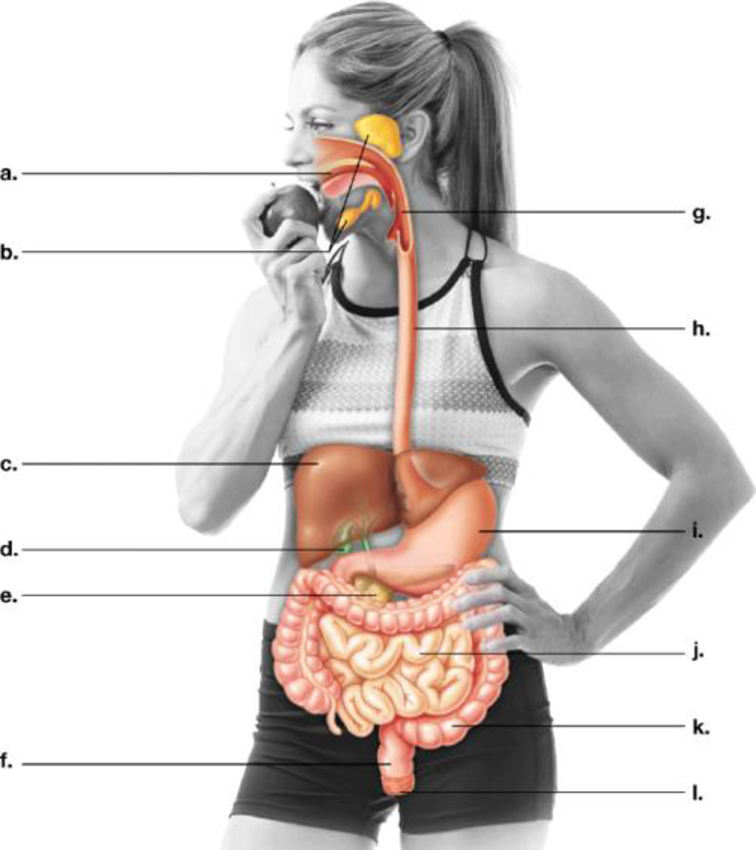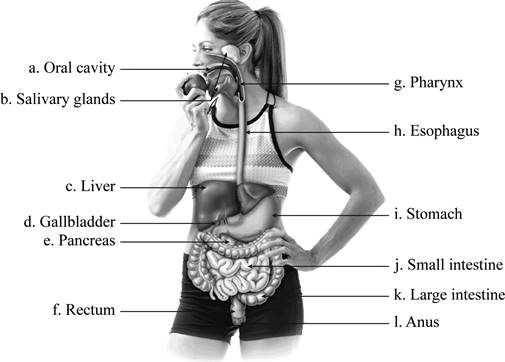
Label the parts of the human

To label: The parts of human digestive system in the figure given and indicate their functions.
Introduction: Human digestive system consists of gastrointestinal (GI) tract and accessory organs. The gastrointestinal tract is made up of mouth, esophagus, stomach, small intestine, large intestine, and anus. The accessory organs for digestion are liver, pancreas, and gallbladder. Each part of the digestive system moves ingested food through gastrointestinal tract, breaks it into small parts, so that they can be absorbed if needed or expelled out.
Answer to Problem 1CC
Pictorial representation: A labeled diagram showing the various parts of a human digestive system.

Fig.1 Human digestive system
Explanation of Solution
(a)
Correct answer: Oral cavity
Explanation: In a digestive system, the first section is ingestion and chewing of food. This is done by the oral cavity or mouth cavity. It consists of lips, cheek lining, teeth, front part of the tongue, gums, and roof of the mouth. Hence, the correct answer is oral cavity.
(b)
Correct answer: Salivary glands
Explanation: The ingested food moves through gastrointestinal tract by the process known as peristalsis. After chewing, the salivary glands form digestive juice called saliva, which moistens food to easily pass through the esophagus into the stomach. Hence, the correct answer is salivary glands.
(c)
Correct answer: Liver
Explanation: The liver’s function is to produce and secrete a digestive juice known as bile. Bile ducts carry bile from liver to gall bladder for storage, and it helps in digestion of fats. Also, the liver contributes in filtering and purifying the blood. Hence, the correct answer is liver.
(d)
Correct answer: Gall bladder
Explanation: Gall bladder is located below liver and stores bile juice. When fatty food enters the duodenum of the small intestine, the gall bladder squeezes into small intestine through bile ducts. Hence, the correct answer is gall bladder.
(e)
Correct answer: Pancreas
Explanation: Pancreas mainly forms digestive enzymes that are released into small intestine through ducts. These enzymes help in digestion of fats, proteins, and carbohydrates. Hence, the correct answer is pancreas.
(f)
Correct answer: Rectum
Explanation: Rectum is a part of the large intestine that connects the colon to the anus. It receives stool from the colon and accommodates it until it is expelled out through sphincters. Hence, the correct answer is rectum.
(g)
Correct answer: Pharynx
Explanation: Pharynx is also referred as throat in the digestive tract. It receives food from the mouth. It branches into the esophagus and the trachea. The esophagus further takes food to the stomach for digestion, and trachea carries air to the lungs. Hence, the correct answer is pharynx.
(h)
Correct answer: Esophagus
Explanation: After ingestion and chewing of food, the food is pushed to the stomach through peristaltic movement. It is carried through the esophagus. The esophagus is also known as food pipe. Hence, the correct answer is esophagus.
(i)
Correct answer: Stomach
Explanation: Stomach is a digestive organ in the abdominal cavity. It secretes digestive enzymes (breaking of large molecules), mucus (moisten), and hydrochloric acid (protection against microbes) for digestion of ingested food. Hence, the correct answer is stomach.
(j)
Correct answer: Small intestine
Explanation: Small intestine is a coiled structure and secretes digestive juices. It consists of folds that contribute in digestion and absorption of nutrients. Hence, the correct answer is small intestine.
(k)
Correct answer: Large intestine
Explanation: Large intestine consists of cecum, colon, and rectum. It helps in absorption of water from the gastrointestinal tract into the bloodstream. The unused particles are moved further into the rectum for elimination. Hence, the correct answer is large intestine.
(l)
Correct answer: Anus
Explanation: Anus is the last part of the digestive system. It is the external opening at the end of rectum for elimination of feces from the body. Defecation is controlled by two sphincters namely internal and external anal sphincters. Hence, the correct answer is anus.
Want to see more full solutions like this?
Chapter 21 Solutions
BSC 1005 PKG-W/MOD. MAST. ACCESS >CI<
- examples of synamtomorphy.arrow_forwardE. Bar Graph Use the same technique to upload the completed image. We will use a different type of graph to derive additional information from the CO2 data (Fig A1.6.2) 1. Calculate the average rate of increase in COz concentration per year for the time intervals 1959-1969, 1969- 1979, etc. and write the results in the spaces provided. The value for 1959-1969 is provided for you as an example. 2. Plot the results as a bar graph. The 1959-1969 is plotted for you. 3. Choose the graph that looks the most like yours A) E BAR GRAPH We will use a different type of graph to derive additional information from the CU, data (rig. nive). Average Yearly Rate of Observatory, Hawall interval Rate of increase per year 1959-1969 0.9 1969-1979 1979-1989 1989-1999 1999-2009 Figure A1.6.2 1999-2009 *- mrame -11- -n4 P2 جية 1989-1999 1979-1989 1969-1979 1959-1969 This bar drawn for you as an example 1.0 CO, Average Increase/Year (ppmv) B) E BAR GRAPH We will use a different type of graph to derive…arrow_forwardUse the relationships you just described to compute the values needed to fill in the blanks in the table in Fig A1.4.1 depth (a) 1.0 cml 0.7 cml cm| base dimensions (b, c)| 1.0 cm| 1.0 cm| 1.0 cm 1.0 cm| 1.0 cm| 1.0 cm volume (V) 1.0_cm' cm'| cm'| density (p) 1.0 g/cm'| 1.0 g/cm 1.0 g/cm' mass (m)| 0.3 g Column 1: depth at 1.0 cm volume mass Column 2: depth at 0.7 cm volume mass Column 3: unknown depth depth volumearrow_forward
- San Andreas Transform Boundary Plate Motion The geologic map below of southern California shows the position of the famous San Andreas Fault, a transform plate boundary between the North American Plate (east side) and the Pacific Plate (west side). The relative motion between the plates is indicated by the half arrows along the transform plate boundary (i.e., the Pacific Plate is moving to the northwest relative to the North American Plate). Note the two bodies of Oligocene volcanic rocks (labeled Ov) on the map in the previous page located along either side of the San Andreas Fault. These rocks are about 23.5 million years old and were once one body of rock. They have been separated by displacement along the fault. 21. Based on the offset of these volcanic rocks, what is the average annual rate of relative plate motion in cm/yr? SAF lab 2.jpg Group of answer choices 0.67 cm/yr 2 cm/yr 6.7 cm/yr 1.5 cm/yr CALIFORNIA Berkeley San Francisco K Os Q San Andreas Fault Ov…arrow_forwardThese are NOT part of any graded assignment. Are there other examples of synapomorphy. What is it called when the traits retained are similar to ancestors?arrow_forwardPlease hand draw everying. Thank you! Draw a gram positive bacterial cell below. Your cell should have the following parts, labeled: A coccus shape A capsule The gram positive cell wall should have the peptidoglycan labeled, as well as its component parts (NAM, NAG, and teichoic acid) A cell membrane Fimbriae A nucleoid Ribosomes Inclusionsarrow_forward
- Draw a gram negative bacterial cell below. Your cell should have the following parts, labeled: A bacillus shape Fimbriae Amphitrichous flagella 2 membranes (outer and inner) The outer membrane should have lipopolysaccharide (LPS) with lipid A and O antigens Periplasmic space The thin peptidoglycan cell wall between the 2 membranes A nucleoid Ribosomes Inclusionsarrow_forwardBacterial species Cell wall type Example: S. mitis Gram positive S. epidermidis H. pylori M. bovis S. marcescens Shape and arrangement Coccus, streptococcus Drawing 0000000arrow_forwardDraw a gram positive bacterial cell below. Your cell should have the following parts, labeled: A coccus shape A capsule The gram positive cell wall should have the peptidoglycan labeled, as well as its component parts (NAM, NAG, and teichoic acid) A cell membrane Fimbriae A nucleoid Ribosomes Inclusionsarrow_forward
 Human Biology (MindTap Course List)BiologyISBN:9781305112100Author:Cecie Starr, Beverly McMillanPublisher:Cengage Learning
Human Biology (MindTap Course List)BiologyISBN:9781305112100Author:Cecie Starr, Beverly McMillanPublisher:Cengage Learning Biology 2eBiologyISBN:9781947172517Author:Matthew Douglas, Jung Choi, Mary Ann ClarkPublisher:OpenStax
Biology 2eBiologyISBN:9781947172517Author:Matthew Douglas, Jung Choi, Mary Ann ClarkPublisher:OpenStax Concepts of BiologyBiologyISBN:9781938168116Author:Samantha Fowler, Rebecca Roush, James WisePublisher:OpenStax College
Concepts of BiologyBiologyISBN:9781938168116Author:Samantha Fowler, Rebecca Roush, James WisePublisher:OpenStax College Human Physiology: From Cells to Systems (MindTap ...BiologyISBN:9781285866932Author:Lauralee SherwoodPublisher:Cengage Learning
Human Physiology: From Cells to Systems (MindTap ...BiologyISBN:9781285866932Author:Lauralee SherwoodPublisher:Cengage Learning





